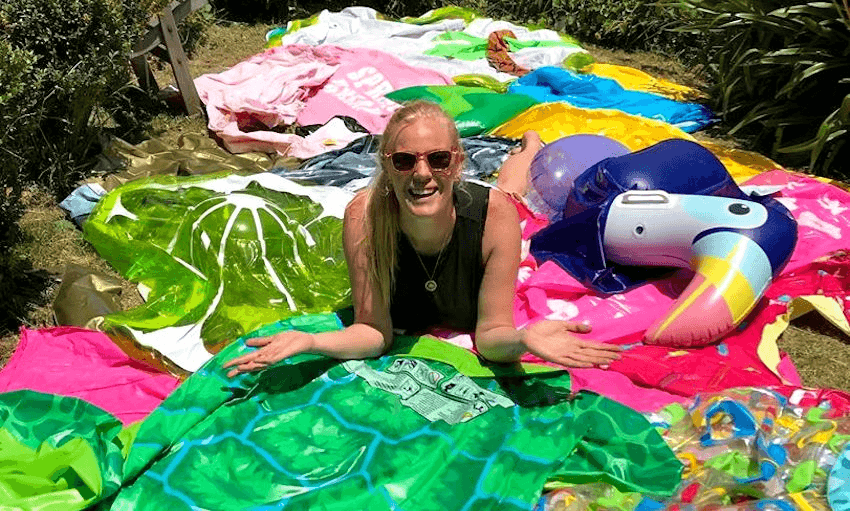Pool toys are cool for the summer, but don’t do so well in landfill. Alex Casey meets a woman trying to prolong the life of New Zealand’s novelty inflatables.
If Instagram is any indication of real life, you’d be forgiven for thinking that the human race is currently being ruled by giant inflatable swans, blow-up watermelon slices and colossal puffy pineapples. Year on year, the range of novelty pool toys available becomes both more elaborate (giant inflatable clam with matching inflatable pearl, anyone?) and more affordable all at once (photorealistic donut for $8.40, anyone?). Great for looking like a weird water angel all summer long, really terrible for the environment.
The problem comes when pool toys inevitably pop, fade, or appear in one too many photos. With prices and quality plummeting, people are far less likely to repair a toy, and much more likely to hit the shops and buy themselves another luxury pegasus to sun their golden mane on. And because they are made out of polyvinyl chloride (PVC) which can’t be recycled, the only disposal option for inflatables is for them to go into landfill, where they will sit in the earth for hundreds of years alongside all the other nappies, tampons and discarded national treasures.
That’s where I Used to Be comes in. Run by Auckland arts facilitator Nina Darrah, the company keeps unwanted inflatables out of landfill by repurposing them into hardy, splash-proof bags. Inspired by her time in the UK, where she met a woman who makes bags out of bouncy castles, Darrah saw an opportunity to prolong the life of one of summer’s favourite accessories. “We’re very conscious now of single-use plastics,” she says, “but things like pool toys are the next step.”
Upon returning to New Zealand early last year, Darrah posted in the Titirangi community Facebook page to see if anyone had any old inflatables and was inundated with responses. Thinking she would be getting a bevy of flamingos and fruits, she quickly realised the need to set some standards. “People gave me paddling pools that had been sitting under their house for about 100 years that were filthy and mouldy… I just used all the crap stuff to practise with.”
Darrah made a couple of non-mouldy pieces and sold them at the local markets, including to one woman who bought her own donated pool toy reborn as a beach bag. Realising she was onto something, Darrah contacted the ZM Float Party, an event that would see a monstrous number of drunk young people floating on their inflatable of choice on Lake Taupō. “I got to come in afterwards and the waste team had put a pile aside for me. I probably got around 100 toys.”
It’s a lot when you consider that Darrah stores them all in her bedroom in Kingsland, which she admits smells a lot like “a toxic wasteland” at the moment. It’s also a lot when you consider that a single toy can make as many as 50 bags in the I Used To Be range. “It’s really interesting when you start taking them apart and seeing the construction of them – there are all these inner chambers to keep them from collapsing, which is what I make the smaller pieces out of.”
She has also held onto every rubber nozzle and plastic handle, convinced that someone will need them for something else.
After a busy Christmas and summer period, Darrah is now working on restocking the sold-out range. And, after one of her posts was shared hundreds of times on Facebook, she’s trying to figure out how to cope with the flood of donations. “The real beauty of it is that it is really easy for people to get behind. It’s obviously not a perfect solution because it’s still a product – ideally we want nobody buying these cheap inflatables at all.”
And if you do have old floaties to donate, please make sure they aren’t yuck. “People treat me like a rubbish truck – it’s like they don’t want to have to be the person who puts the bad thing in the bin, so they palm it off to somebody else to do. You convince yourself that someone will want it or someone will use it, but they just don’t.” Mould is no good, and stubborn pink soap scum won’t look great in your beach snaps. “People are offering up airbeds too, but I don’t have capacity to deal with those at the moment.”
Still, the dud donations are in the minority and Darrah remains constantly amazed at the bizarre range of inflatables that people acquire. “The best one I have got is probably a geometric patterned llama. A pineapple was another big favourite of mine. I drove out to Waiuku to pick up a big lobster and I had a big whale arrive from Rhythm and Vines. Someone actually messaged me saying they have a popped toucan the other day, I am very excited about that.”
None compare to her own golden goose: a Sunnylife mermaid ring. “They’re my dream donation. Beautiful turquoise on the bottom, clear on the top with shiny mermaid print.
“I’m just waiting for someone to pop one.”

